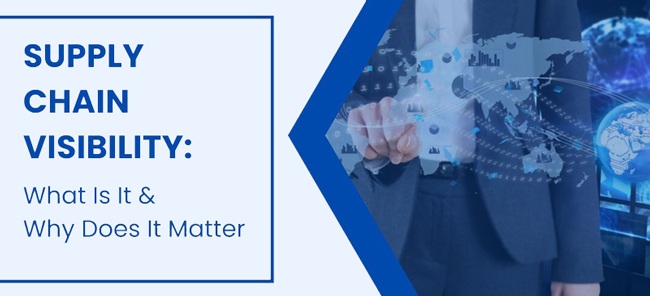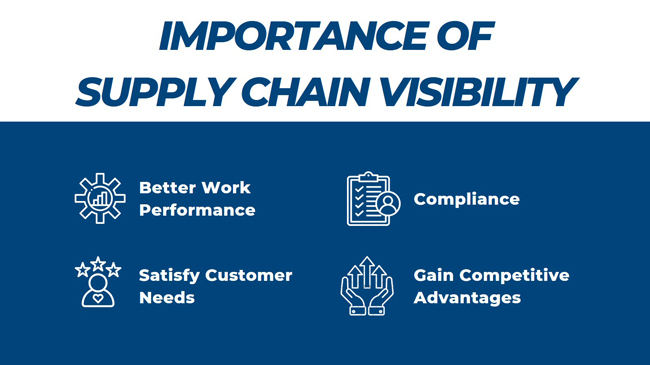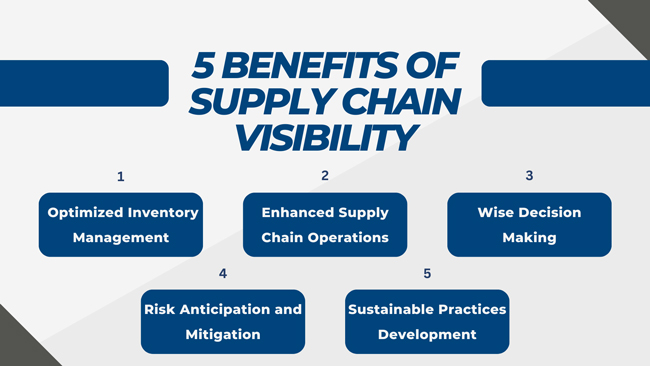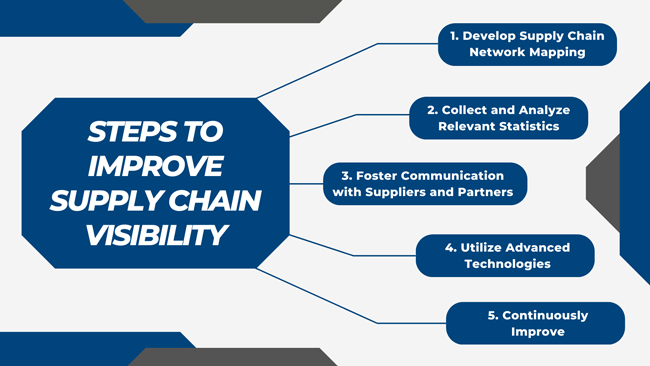Supply Chain Visibility: What Is It and Why Does It Matter
- Date:
- Author: SVI Content Team
- Share:

In a hyper-connected world where success hinges on efficiency and agility, one factor reigns supreme: supply chain visibility. It needs you to put your business into perspective and re-examine the old business strategies. If you’re seeking clarity on this pivotal concept, you’ve come to the right place.
This blog intends to define supply chain visibility and show you its advantages and steps to increase visibility. Don’t hesitate any longer—unleash your business potential by unravelling the hidden power of supply chain visibility. It is the key to unlocking operational excellence, seamless collaboration, and a competitive edge that propels your success to new heights.
Part 1. Why Supply Chain Visibility Matters?
1. What Is Supply Chain Visibility?
Supply Chain Visibility (SCV) refers to the capability of obtaining precise and pertinent information in real time regarding the diverse activities, processes, and occurrences taking place within the supply chain. It involves the collection and integration of data from various sources throughout the supply chain, from upstream suppliers to downstream customers, to establish a comprehensive understanding of the entire supply chain network, encompassing raw materials to final products.
The goal of supply chain visibility is to improve the competitive edge of the company by collecting data and having a clear overview of the supply chain.
SCV has several different types, including:
- Multi-tier supply chain visibility: It is to gather information and gain visibility from multiple levels of stakeholders in the supply chain network.
- Real-time supply chain visibility: It tracks and processes up-to-date information and data during supply chain activities.
- End-to-end supply chain visibility: It covers the entire supply chain, from the initial raw material stage to final product delivery. It requires the collection and integration of data from all stages and related entities.
2. Why Is Supply Chain Visibility Important?
The capability to track activities and information within the supply chain empowers organizations to gain insights into their operations, optimize processes, identify bottlenecks, and effectively respond to disruptions or shifts in demand. Achieving the objective of supply chain visibility is crucial for driving the company’s growth and development. Here’s the importance of supply chain visibility:
✔ Better Work Performance
Supply chain visibility presents all sectors and processes in the supply chain in the form of visualization using technology, which enables operators to clearly understand and monitor the real-time status and operation of the supply chain.
By gaining visibility into the supply chain, companies can enhance their operational performance by quickly recognizing inefficiencies and areas for improvement, and reducing information lag to improve responsiveness.
✔ Satisfy Customer Needs
Supply chain visibility allows organizations to meet customer demands more effectively. It provides businesses with the flexibility and responsiveness to speed up order fulfilment and meet changes in customer demand promptly. Why? This is achieved through real-time monitoring of shifts and trends in market demand, overseeing inventory levels, and providing timely and visible supply chain logistics order tracking and updates.
✔ Compliance
When a company choose to source parts of operations externally, having visibility into the supply chain greatly assists in ensuring compliance with regulatory requirements, industry standards and ethical practices. It enables companies to assess whether suppliers and partners adhere to local regulations. If there are potential compliance issues, companies can take appropriate measures to avoid penalties and minimize the adverse consequences associated with non-compliance.
✔ Gain Competitive Advantages
Supply chain visibility can provide organizations with a competitive edge in the market. It allows for quicker response times to changing market conditions, lowered operational expenses, better inventory management, and the ability to offer value-added services like real-time shipment tracking or personalized customer experiences. These capabilities differentiate a company from its competitors and attract customers seeking reliable and transparent supply chains.
Part 2. 5 Benefits of Supply Chain Visibility
Supply chain visibility contributes significant value to the growth of a company. And the advantages of supply chain visibility include:
1. Optimized Inventory Management
By gaining real-time information and tracking the shipments, it is easy for companies to effectively monitor and manage their inventory. In this way, they can optimize inventory levels, reduce carrying costs, and adjust inventory based on market trends to avoid overstock or stockouts.
For example, a company selling electronic gadgets utilizes supply chain visibility to monitor real-time inventory information. They notice a surge in demand for a specific smartphone model. With supply chain visibility, they quickly adjust inventory levels to replenish stocks of popular models and minimize excess inventory of less popular models. As a result, they are able to meet customer demand consistently, reduce holding costs, and gain a competitive edge in the marketplace.
2. Enhanced Supply Chain Operations
Supply chain visibility delivers real-time perspectives and data across the entire supply chain, providing a thorough understanding of key processes and activities. This visibility makes it possible to help businesses recognize inefficient or redundant steps in their operations. By analyzing such information, they can streamline processes, eliminate unnecessary tasks, and optimize workflows. This results in shorter lead times, increased productivity and better operational efficiencies.
3. Wise Decision Making
With SCV, enterprises can analyze real-time information and gain a 360-degree view of the current state of their supply chain. Armed with valuable knowledge, enterprises to make informed decisions and tackle problems in production, procurement and logistics, thus driving operational excellence and improving business performance.
4. Risk Anticipation and Mitigation
A visible supply chain management is instrumental in identifying and mitigating risks within a company’s operations. With SCV, companies can proactively monitor various aspects and anticipate potential risks such as supply chain disruptions, shipment delays or quality issues. Moreover, companies can create contingency strategies ahead and swiftly react and implement measures to minimize losses when unexpected risks arise, ensuring the resilience of their supply chains.
For example, if a supplier experiences production delays, companies can quickly identify alternative suppliers or adjust production schedules to ensure continuity.
5. Sustainable Practices Development
Supply chain visibility supports the development of sustainable practices by enabling organizations to monitor resource usage, reduce waste, and ensure ethical sourcing. The visibility helps companies to a full ability to manage their supply chains and spot the issues quickly. Businesses can take social compliance audits or environmental audits to collect information.
Based on that, they can track waste generation and then implement strategies to optimize resource consumption. Additionally, supply chain visibility helps ensure ethical sourcing by tracing the origin of materials and taking corrective actions when necessary.
Companies can leverage the insights gained from supply chain visibility to make informed decisions aligned with their sustainability goals, contributing to long-term environmental and social sustainability.
Part 3. How to Improve Supply Chain Visibility
Since enhancing global supply chain visibility yields numerous benefits, how can you achieve and increase visibility in supply chain? Let’s explore the steps below.
1. Develop Supply Chain Network Mapping
Start by defining clear objectives for achieving visible supply chain management. Define what specific aspects of the supply chain you want to make visible and the goals you aim to accomplish through improved visibility.
And then create a comprehensive map of your supply chain, including all the entities involved, from suppliers to customers. The key processes, players, and information flow within the supply chain should be identified. The visualization will give you a full perspective that can help find out your dependency on suppliers or issues to optimize performance.
2. Collect and Analyze Relevant Statistics
After that, it’s time to collect relevant data and analyze it thoroughly, with comprehensive data on product demand, inventory, lead times, and more. This process needs to establish standardized data formats, terminology and flows across the supply chain to ensure consistency and compatibility. It is also helpful for businesses to define performance metrics, and exchange and integrate data between systems and partners for better visibility and decision-making.
3. Foster Communication with Suppliers and Partners
To enhance visibility in the supply chain, it is vital to foster communication with suppliers and partners. Businesses can build collaboration and information sharing with suppliers, manufacturers, logistics providers, and customers. Establish a supplier relationship management framework, create open lines of communication, share data and ideas, and align goals and expectations to improve global supply chain visibility across the whole process.
4. Utilize Advanced Technologies
Implement advanced technology solutions that facilitate supply chain visibility. This may include incorporating cloud-based software, Internet to Things (IoT) devices, data analytics tools, track-and-trace systems, and real-time monitoring platforms. Choose solutions that align with your specific visibility objectives and integrate them into your existing system. These advanced technologies can capture, analyze, and share real-time supply chain data among stakeholders, which promotes transparency, trust and efficiency.
5. Continuously Improve
Continuous improvement is a key principle that applies to various strategies and initiatives such as Lean Manufacturing. And improving supply chain visibility is no exception. It is an ongoing process. Continuously and regularly assess and improve your visibility initiatives based on feedback, key performance indicators (KPIs), and changing market conditions. Stay updated with emerging technologies and industry best practices to adapt and enhance your visibility strategies over time.
Part 4. Conclusion
While today is an information-driven world, the one who masters the all-sided source will have more chances to be successful. Supply chain visibility is an important part of this process, offering benefits such as increased efficiency and customer satisfaction and others that help you distinguish yourself in the market. To improve your supply chain visibility, you need to gather and break down information at every stage of the process.
An important aspect of achieving visibility in supply chain is to find perfect suppliers who understand your specific needs and establish strong relationships with them. Effective collaboration with suppliers is key to driving successful outcomes. If you are searching for a trusted partner in this regard, SVI Global is your best bet. As a practised partner with services, we are acquainted with the market conditions and can manage your supply chain management effortlessly. For more information on how SVI Global can unlock the full potential of your supply chain, explore our capabilities.









